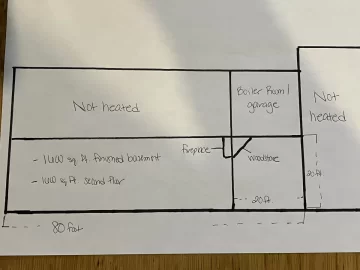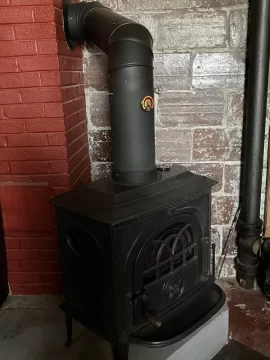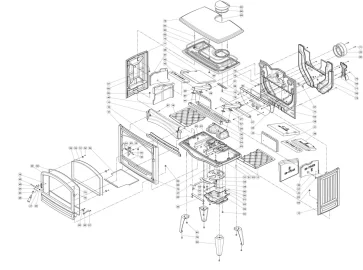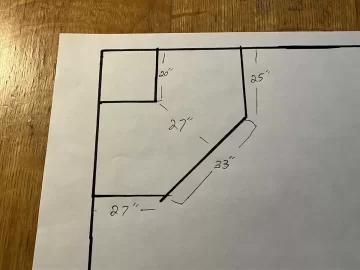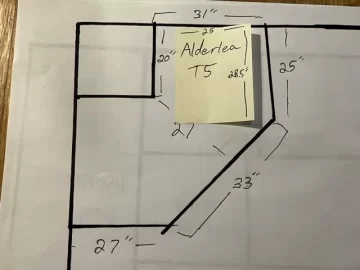I've been heating with a Jotul spin draft 8 for many years, and it's been a really great stove. I'm looking into more fuel efficient options, and I would like slightly more heat output. It's size currently fits our needs 95% of the time. I see square foot and BTU information for the later Jotul Series 8, but haven't been able to find much information on the older first generation stove. The heating space is kind of unusual. The stove and a Jotul C350 fireplace insert are located in a basement. I'm located in Wisconsin at about 1,300 elevation and on top of a hill. (Strong draft) House construction is all masonry and it's 101 years old. Basement exterior walls have some interior insulation on the north and east sides. The south and west sides are garages and storage rooms that are not regularly heated but generally maintain around 40-50 degrees. the basement is long and narrow, (80' x 20') and the room where the stove is located is 20' x 20' with a 10' ceiling. The adjacent room where the fireplace is located has an 8' ceiling, and there is a 4' wide doorway connecting the rooms. Stairway to the first floor is on the far east side of the house, and opposite the wood stove room.
General info
-Heating 3,200 Sq.Ft. total (1,600 basement, 1,600 first floor)
-25' x 7" insulated stainless steel woodstove chimney is inside an 11" square masonry flue, and not on an exterior wall.
-Current stove sits on an elevated concrete corner pad which extends 27" from the corner of the chimney. I could poor more concrete if the perfect stove needs more depth. Original stove was a Royal Oak potbelly which I still have sitting in a garage as decoration.
-Two basement walls are very thick limestone, and some other walls are ceramic coated clay block, or 11" thick cement block.
-Wood stove is used every day, but is not run overnight. I may consider running a new stove overnight.
-Current connector pipe is 7" single wall
-No clearance to combustibles concerns
-Other heat source is oil burning hydronic boiler (adding outdoor wood boiler would be complicated)
Some of the new stoves I'm considering (Tax credit would be nice, but I'm not opposed to less then 75% efficiency if that stove is the best fit)
-Jotul F55 V2 (May be too large and make 20'x20' room uncomfortable?
-Jotul F45 (Too long for current raised hearth)
-PE Alderla T4,5,or 6
-Morso 7110B (A favorite, but may be too small)
-Lopi Rockport
-BK Ashford 20
-Woodstock Progress or Ideal Steel Hybrid
I would greatly appreciate any suggestions or feedback. Thanks!
General info
-Heating 3,200 Sq.Ft. total (1,600 basement, 1,600 first floor)
-25' x 7" insulated stainless steel woodstove chimney is inside an 11" square masonry flue, and not on an exterior wall.
-Current stove sits on an elevated concrete corner pad which extends 27" from the corner of the chimney. I could poor more concrete if the perfect stove needs more depth. Original stove was a Royal Oak potbelly which I still have sitting in a garage as decoration.
-Two basement walls are very thick limestone, and some other walls are ceramic coated clay block, or 11" thick cement block.
-Wood stove is used every day, but is not run overnight. I may consider running a new stove overnight.
-Current connector pipe is 7" single wall
-No clearance to combustibles concerns
-Other heat source is oil burning hydronic boiler (adding outdoor wood boiler would be complicated)
Some of the new stoves I'm considering (Tax credit would be nice, but I'm not opposed to less then 75% efficiency if that stove is the best fit)
-Jotul F55 V2 (May be too large and make 20'x20' room uncomfortable?
-Jotul F45 (Too long for current raised hearth)
-PE Alderla T4,5,or 6
-Morso 7110B (A favorite, but may be too small)
-Lopi Rockport
-BK Ashford 20
-Woodstock Progress or Ideal Steel Hybrid
I would greatly appreciate any suggestions or feedback. Thanks!


